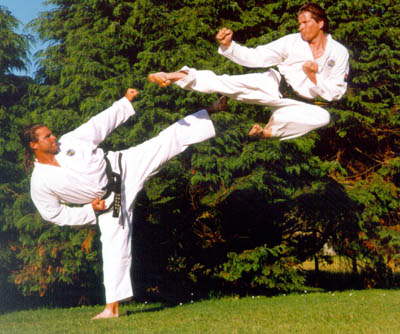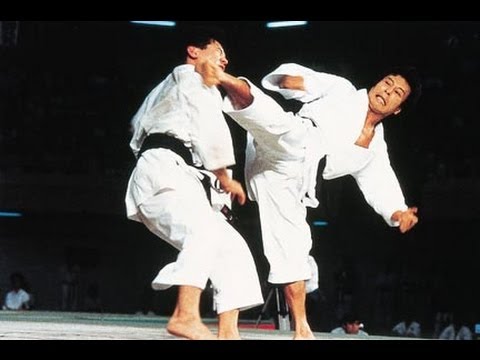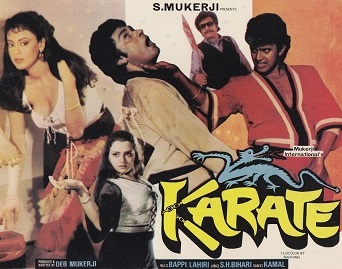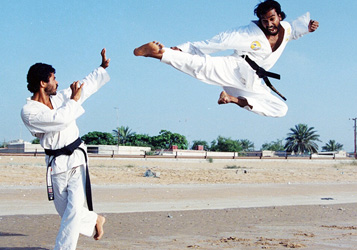The World of Kung-Fu 5.3: Karate
Karate: The Feuding Samurai
Q: “What kind of car is always full of gas?”
A: “A karateka”—Ronin joke.
The stereotype of a Karateka is an impulsive, violent, angry, and fundamentally unstable martial artist. This is largely due to the fact that American Karate has been at civil war since the 1950s. Fueled by competitiveness over which style of Karate is the best, the so called Karate Wars are not over anything in particular. Like lots of longstanding feuds, they are fought over hundreds of grievances accumulated over the years with more being added all the time. Karateka frequently fight in public, generally after practitioners of one style stumble across practitioners of another. Despite the violence and property destruction, witnesses almost always forget these fights and the general public remains unaware of them.1
Karate tournaments are theoretically neutral ground and every popular school declares it a dishonor to start a fight there. Yet fights keep breaking out at mixed tournaments attended by Karateka of different styles, with each side blaming the other for starting it.
The Karate Wars are furious, but carried out “honorably”, which means that (mostly) nobody dies and nobody is maimed. If someone does die or becomes maimed, this is a dishonor for everyone who uses the same style as their attacker. It suggests a lack of skill at best and viciousness at worst. It is also considered dishonorable for civilians to get hurt in the chaos, though destroying their property is acceptable.
“Let me tell you a story ‘bout Minnie the Mouth / Karate queen from way down south.
Wasn’t that strong. Didn’t stand too high. / But my sweet lord, you should’ve heard her kiai.
Ki-yi yi-yi yi-yi- yi-yi! Ki-yo yi--yo yi-yo yi-yo!…”—“Minnie the Mouth”, “Crab” Galloway, 1930.
Many Americans train in Karate. Few of them have even heard of a “Karate War”. However, the more that a devoted student focuses on Karate, the more likely that they will be drawn into the feuds and violence. Those who are Trained by a Master are particularly likely to feel a duty to defend the honor of their style. After all, when you insult their style, you insult their sensei! However, most combatants in the Karate Wars are not Trained by a Master. The popularity of Karate ensures a healthy supply of foot-soldiers, ready to give their all for the honor of the style.2
Stereotypes of Karate Styles
“The nail that sticks out must be punched down.”—Karate saying.
The Karate Wars have resulted in a lot of negative stereotyping of practitioners of the various Karate styles by practitioners of other Karate styles. The following stereotypes don’t necessarily reflect what stylists are actually like, but how they are unfairly depicted by their enemies.
Goju-ryu: Dishonest and manipulative.
Isshinryu: Greedy and acquisitive.
Kyokushin: Decadent and hedonistic.
Shito-ryu: Disloyal and untrustworthy.
Shorin-ryu: Reckless and foolhardy.
Shotokan: Arrogant and bragging.
Uechi-ryu: Boorish and bad-mannered.
Wado-ryu: Deluded and crazy. They are sometimes referred to as “Wacko-ryu” or “the Wado whackos.”
How Did the Feuds Start?
“It is a truth universally acknowledged that a young woman of ill fortune must be in need of revenge.”—Jane Austen, Lady Dragon, 1812.
The details of the events leading to the various feuds behind the Karate Wars are hazy and vague. Exactly when they occurred, who they involved, and precisely what happened, is usually unknown, which doesn’t stop the accusations flying again and again. Once a feud has started, the violence ensures that there will always be enough perceived wrongs on both sides to keep the feud burning.
The Big Six Karate Feuds
There are the six main feuds driving the Karate Wars, all between the four styles Goju-ryu, Isshinryu, Kyokushin, and Shotokan Karate. These feuds are always “hot” and members of feuding styles will rarely cooperate.
Goju-ryu vs. Shotokan: Shotokan says that they confided to Goju-ryu that they were considering proposing an alliance to Kyokushin. Goju-ryu then told Kyokushin, and Goju-ryu and Kyokushin laughed at Shotokan.
Isshinryu vs. Shotokan: Isshinryu says that they told Shotokan that they were developing a tiger symbol to use to represent their Karate. Shotokan subsequently adopted the tiger as their symbol. Shotokan said that they were on the verge of adopting the tiger as their symbol anyway, before Isshinryu told them.
Kyokushin vs. Shotokan: Shotokan says that Kyokushin has been calling them arrogant behind their back, and saying that they aren’t as good at Karate as they claim. Kyokushin generally admits that they have been saying these things, and are willing to say them to Shotokan’s face.
Goju-ryu vs. Isshinryu: Issinryu says that Goju-ryu lied to Kyokushin, telling Kyokushin that Isshinryu said that Kyokushin Karate is derivative of Goju-ryu and Shotokan Karate.
Goju-ryu vs. Kyokushin: Goju-ryu and Kyokushin were once in alliance, before Kyokushin broke it off. Kyokushin claims that Goju-ryu exploited Kyokushin’s love of training to dominate the alliance, manipulating Kyokushin to distract them from political and strategic decisions being made on behalf of the alliance. Kyokushin feels used and that Goju-ryu doesn’t respect their opinions. Goju-ryu claims that Kyokushin is at fault for enjoying themselves training rather than participating in administration.
Isshinryu vs. Kyokushin: Kyokushin says that Isshinryu have been saying behind their back that Kyokushin Karate is derivative of Goju-ryu and Shotokan karate.
Other Karate Feuds
Every two Karate styles have something to feud over. These feuds sometimes run hot and are sometimes are put aside for temporary alliance. Members of feuding styles may fight or cooperate, depending on recent events.
Goju-ryu vs. Shito-ryu: Goju-ruy says that Shito-ryu made alliance with them, but then joined Shotokan in attacking them. Shito-ryu says that it was Goju-ryu who broke the alliance when they lied to them to get them to attack Shotokan, telling them that Shotokan had declared peace with the Ninja.
Goju-ryu vs. Shorin-ryu: Shorin-ryu says that Goju-ryu tricked them into attacking Isshinryu. Shorin-ryu says that Goju-ryu lied to them, saying that the other Karate styles were saying that Shorin-ryu doesn’t have the guts to attack Isshinryu for saying behind their backs that Shorin-ryu are reckless.
Goju-ryu vs. Uechi-ryu: Goju-ryu says that they let Uechi-ryu use their dojos, but that Uechi-ryu never properly cleaned or tidied up after themselves, which was highly disrespectful and eventually lead to Goju-ryu not letting Uechi-ryu use their dojos anymore. Uechi-ryu says that they cleaned and tidied up meticulously, and that Goju-ryu was just looking for a reason to throw their weight around.
Goju-ryu vs. Wado-ryu: Some members of Wado-ryu have been saying that Goju-rya has been infiltrated by evil organizations. Evil organizations said to influence or control Goju-ryu include the Illuminati, the International Monetary Fund, and Wushu.
Isshinryu vs. Shito-ryu: At one time, Isshinryu was renting out dojo to Shito-ryu. Shito-ryu feels that they were treated dishonorably by having been asked to pay. Isshinryu insists that some Shito-ryu schools still owe money to Isshinryu, which Shito-ryu adamantly denies.
Isshinryu vs. Shorin-ryu: Shorin-ryu claims that Goju-ryu lied to them to get them to attack Isshinryu, by telling them that Isshinryu were allowing their dojo to be rented for Taijutsu classes. Isshinryu is furious about being attacked for no reason, while Goju-ryu is angry about being blamed and retaliated against when it is all Goju-ryu’s fault.
Isshinryu vs. Uechi-ryu: At one time, Isshinryu was renting out dojos to Uechi-ryu. Isshinryu claims that Usechi-ryu students were bad mannered to Isshinryu students, and in particular, that some Usechi-ryu students were belching in the dojo. Uechi-ryu is deeply offended that Isshinryu could make such an accusation, insisting that Uechi-ryu students would never act so dishonorably.
Isshinryu vs. Wado-ryu: Some members of Wado-ryu say that Isshinryu has been infiltrated by criminal organizations. Criminal organizations said to influence of control Isshinryu include the New Yakuza, the Ninja, and the Five Venoms.
Kyokushin vs. Shorin-ryu: Kyokushin says that Shorin-ryu took advantage of their friendship to pressure them to make military alliance. Kyokushin feels used. Shorin-ryu says that Kyokushin deliberately lead them to believe that they were interested in alliance. Shorin-ryu feels unfairly treated.
Kyokushin vs. Shito-ryu: Kyukushin told Shito-ryu that Goju-ryu are dishonest, and Shito-ryu told Goju-ryu what Kyokushin had said. Shito-ryu says that Kyokushin never said that it was supposed to be a secret.
Kyokushin vs. Uechi-ryu: Kyokushin says that Uechi-ryu has been calling Kyokushin Karate “inelegant” and “brutish”. Uechi-ryu denies that they had made such accusation prior to being accused of making them and suffering reprisals, but they generally call Kyokushin Karate “inelegant” and “brutish” now.
Kyokushin vs. Wado-ryu: Some members of Wado-ryu say that Kyokushin has been infiltrated by supernatural organizations, especially vampires. Some Wado-ryu say that Kyokushin are in vampires’ thrall, and some that numerous Kyokushin have personally become vampires.
Shito-ryu vs. Shorin-ryu: Shorin-ryu says that Shito-ryu invited them to cooperate on the project of writing the “ultimate true history of Karate.” However, once Shorin-ryu had committed themselves and begun research, Shito-ryu left them to do the work while they spent time boasted about the project to other Karate styles. The great work was eventually abandoned, with much bitterness.
Shito-ryu vs. Shotokan: Shito-ryu and Shotokan were once allied, but Shotokan became resentful when Shito-ryu failed to speak up to defend Shotokan when Kyokushin was saying behind Shotokan’s back that Shotokan is arrogant and not as good at Karate as they think they are. Shotokan broke off the alliance with Shito-ryu in outrage.
Shito-ryu vs Uechi-ryu: Shito-ryu and Uechi-ryu were once allied. Uechi-ryu says that Shito-ryu never wanted to train or spar with them, and then they discovered that Shito-ryu had been training and sparring with Kyokushin. Uechi-ryu broke off the alliance, feeling betrayed. Shito-ryu says that they never promised not to spar and train with other styles, and besides, Kyokushin was treating them with honor while Uechi-ryu took them for granted.
Shito-ryu vs Wado-ryu: Shito-ryu boasts that with 94 kata, it has more kata than any of the other major styles. Wado-ryu has been saying that it doesn’t matter how many kata a style has, a claim that infuriates Shito-ryu.
Shorin-ryu vs. Shotokan: It isn’t clear how the feud began, but both sides are angry that the other has not been willing to end the feud on “honorable” terms, where “honorable terms” means admitting that you are most to blame.
Shorin-ryu vs Uechi-ryu: Shorin-ryu and Uechi-ryu accuse each other of using styles that are derivative of Chinese Kung Fu rather than distinctively Japanese. Uechi-ryu says that Shorin-ryu is derivative of Wing Chun while Shorin-ryu says that Uechi-ryu is derivative of Pangai-noon Kung Fu. Both styles proudly acknowledge their own Chinese roots but denounce the Chinese roots of the other style, using complex arguments to explain why the two cases are completely different.
Shorin-ryu vs. Wado-ryu: Shorin-ryu and Wado-ryu are the two most popular Karate styles that emphasize “soft” over “hard” techniques. This has lead to a bitter rivalry over whose soft techniques are best, leading to frequent fights to prove the point. Both Shorin-ryu and Wado-ryu tend to irritate practitioners of other styles by going on about the irresistible power of “balanced” Karate.
Shotokan vs. Uechi-ryu: Shotokan and Uechi-ryu were once in alliance, but split in mutual acrimony. Shotokan says that Uechi-ryu stopped showing them respect once they were allied. They feel taken for granted. Uechi-ryu says that Shotokan wouldn’t communicate, which doomed the alliance. They feel betrayed.
Shotokan vs Wado-ryu: Some Wado-ryu insist that Shotokan is a front for a Mongol conspiracy, dating back the Mongol attempt to conquer Japan under Kublai Khan in the 13th century. Shotokan’s true goal is to place Japan under secret Mongol rule.
Uechi-ryu vs. Wado-ryu: Wado-ryu says that Uechi-ryu said things that implied disrespect for Okinawa, the source of Karate, though exactly what was said varies in different accounts. Wado-ryu insists that Uechi-ryu apologize to Okinawa. Uechi-ryu refuses to apologize on the grounds that they did not, and never would, say anything disrespectful about Okinawa.
Karate Relations
“Eagles are screaming.
Horses trampling shakes the earth.
The neighbor’s dojo.”—“Sleepless Haiku”, Matsuo Bashō, Tokugawa Shogunate, 1690.
Karate generally does not concern itself much with outsiders, being focused on its internal war. The Wulin and Vigilantes see Karate as having gone insane. Both want Karate to join the Kung Fu Wars, but after so many decades of civil war, it seems that Karate is doomed to fight itself forever. The Circle of Iron was so horrified at the Karate Wars that they established the Circle of Iron tournament circuit to reduce conflict between Korean martial arts. Even this pales to the response of the Ronin, who gave up on all rules and social convention, maintaining that as long as the Karate Wars last, there is no society for students of the Japanese martial arts. Kyokushin and Shotokan suffer the additional stigma of being popular styles in the Infinite Fighting Federation.
Karate hates Ninja. Ninja make them furious. They would even rather fight Ninja than one another. If anything can get two feuding Karateka to cooperate, it is the prospect of fighting Ninja. Karate often finds Shorinji Kempo fighters annoying, since Shorinji Kempo fighters nag them about Buddhist values, and assume that Shorinji Kempo should lead the Japanese martial arts.
Karateka as Heroes
Most Karateka have a passionate sense of honor. For all the feuding this has lead to, it can also turn Karateka into defenders of the weak and oppressed. Many Vigilante are Karateka, as are some Ronin heroes, and some entire Karate dojos dedicate themselves to protecting their neighborhood or fighting Ninja and Yakuza. Heroic Karateka are sometimes seen as a mixed blessing by other good guys, since they have a reputation for being impulsive hotheads and for being prone to brawling with other Karateka. On the other hand, nobody can deny their bravery, tenacity and effectiveness in battle, all of which force a certain respect.
Q: “Sifu, why do Ninja wear black?”
A: “So that they will not be noticed.”
Q: “So…Why do Karateka wear white?”—Wulin joke.
Karateka as Villains
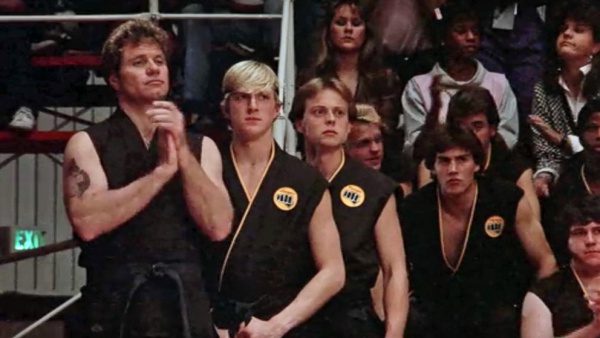
Karate is popular enough that many criminals become Karate students. However, the most dangerous Karateka are the “honorable” ones who are focused on winning the Karate Wars. As every connected martial artists knows, the Karate Wars are a terrible public menace, with wild Kung Fu taking place in crowded urban locations. While no civilians have been killed or badly injured so far, thanks to the great skill of the combatants, good guy martial artists have often had to intervene to put an end to battles of too great a size and destructiveness. The failure of the public to become aware of the Kung Fu war even in the face of periodic mass Karate brawls in broad daylight has convinced many good guys that trying to keep Kung Fu secret is a pointless effort, since the Wushu Effect prevents them from remembering even open warfare.
Footnotes
1. Martial arts songs often celebrate or protest the Karate Wars. For example, the 1985 pro-war song “You Gotta Right to Go Out and Fight Karate” by Four-Animals Boys on Licensed to Kiai.
When a man fights Karate, he needs to go out and scrap.
But your parents give you all kinds of crap.
Your mom won’t let you go out in your gi. / So you just stay home and cultivate ki.
You gotta right to go out and fight Karate!
Your parents say violence is not the way.
Meanwhile, Shotokan struts round all day.
Your old man tells you to give peace a chance. / But Uechi-ryu does the chicken dance.
Bwuck! Bwuck! Bwuck! Bwuck! Bwuck!
You gotta right to go out and fight Karate!
Your mom says street-fighting just isn’t safe.
There are times you suspect that she’s not very brave.
Your dad busts in and shouts, “What’s that noise?”
“That’s ‘Phoenix Rising in the Void!!’ Ha ha ha ha ha!”
You gotta right to go out and fight Karate!
2.The high proportion of Karateka who lack Trained by a Master results in an unusual number of Karate songs being about feelings of inadequacy and the lack of ki. Consider, for instance, “(I Can’t Get No) Satisfaction” by Moss Rocks, (1964).
I can’t get no satisfaction. / I can’t get no ki reaction.
Cause I try to kiai but I got no supply. / I can’t get no. / I can’t get no.
When I’m strainin’ my chakras / And my sensei says, “Be patient Joe”
And he’s tellin’ me more and more
About some cryptic information / That’s supposed to blow my imagination.
I can’t get no, oh no no no / Hey hey hey, that’s my sensei.
I can’t get no satisfaction. / I can’t break things through inaction.
Without ki, I’m a pea. I’m a wee bonsai tree! / I can’t get no, I can’t get no.
When I’m tryin’ to bust some ki / And my sensei comes and tells me
“Just relax and let it be.”
But he don’t understand / Cause his kiais can
Knock the birds right out of trees.
I can't get no, oh no no no / Hey hey hey, that's my sensei!
I can't get no satisfaction / I can't get no ki reaction
Cause I try Dragon Eye but I just break my sai / I can't get no, I can't get no.
And I’m tryin’ flying kicks / And I’m hurtin’ this and I’m sprainin’ that
And I’m tryin’ to break bricks / Sensei says, “Be patient. You might get it next week.
Practice focused breathing and your basic techniques.”
I can't get no, oh no no no / Hey hey hey, that's my sensei.
I can't get no, I can't get no / I can't get no satisfaction
No fist-impaction, no light refraction, no Wuxia action.
